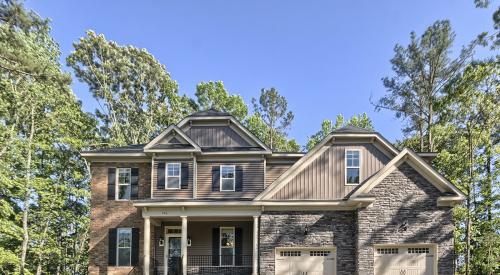| This 2,860-square-foot prototype for Kennedy Homes’ new product line was built at a hard-cost savings of $6,400. |
Tom Gillespie, vice president of housing for suburban Chicago builder Kennedy Homes, says “the real breakthroughs in hard costs will not come from quantity buying of materials as much as by simplifying the plans we build to reduce the number of parts we must assemble, and the way those parts go together.
“Smaller builders can beat the GIANTS. We don’t have to match their purchasing. All we have to do is offer buyers 500 extra square feet of living space for the same price.”
Kennedy has the numbers to back up that claim. This year the disciple of Jack Robinson’s “Rayco model” of regularized production will close 280 houses and sell 400, at an average price of $210,000. “Next year we’ll close 525,” Gillespie says. “We’ve had a 60% increase in sales and a 40% increase in closings each of the last three years. We’ve broken through on market recognition of compelling value.”
Toward that end, Gillespie claims he is leading Kennedy’s value-engineering of house plans further than any builder has ever gone — into a tricky balancing act to reduce the kit of parts for each home without creating product lines that are viewed as Plain Jane by move-up home shoppers.
“Can we standardize a bathroom to fit each of our homes, then design multiple options, in a space that is the same size and shape, to give buyers the choices they want at minimal cost?” Gillespie asks. “Can we get to a low number of cabinet sizes so we can go to a supplier and buy a lot more of each? That will get us better pricing and, by reducing errors in the field, lower hard costs as well as bettering customer satisfaction.”
Gillespie believes that reducing operational variations is the key to improving the price/value equation.
“In the product line we are developing for next year, we’ve reduced costs on one prototype house by 5% — $6,400 — and by the time we get done, you won’t be able to tell it apart from the house of the same size we built this year,” Gillespie says.
Kennedy’s close allies in this value-engineering foray are the trade contractors and work crews who build the houses. “We sat down with every trade, individually and in groups, and showed what we’re trying to accomplish and how it fits into our overall goal to increase consistency and productivity for us and for them,” Gillespie says.
The firm listened to each trade, taking into account how change and variability hurt each partner, and then addressed every issue. “A lot of it had to do with roof design,” Gillespie says. “We had to design our roofs to be much simpler and more consistent.”
The big challenge, Gillespie acknowledges, is to do all this while designing houses that will sell.
“We start with an ugly box. I take the base house down so low in our conceptual planning, you can’t tell the front elevation from the back. We know we’ll never sell that, but we do it for a reason. Most builders have an ‘A’ elevation as a base, but they don’t even know what it costs because they never build it. We take our houses down to butt-ugly, then put an ‘A’ elevation on and calculate exactly what it costs. When we make any design adjustment, we know the costs precisely.”
Gillespie has his trades and architects using a computer-aided design program and e-mailing designs back and forth to speed the development of the new product line.
“We’ve taken that new product from design concept to finished working drawings, ready for permit applications, in less than 30 working days per plan,” he says. “It used to be that we’d work on a new product line for six months and still not be ready to build anything. Next year we’ll move this whole process onto the Web. There are now enough trades that are computer-savvy so that we can make this a condition of employment very soon.”
And through it all, Gillespie remains unfazed by national builders and their perceived purchasing advantage. “They’re picking up pennies while dollars are blowing out the door,” he says. “They’re looking at the price of sticks. We’re looking at the efficiency of processes.”











